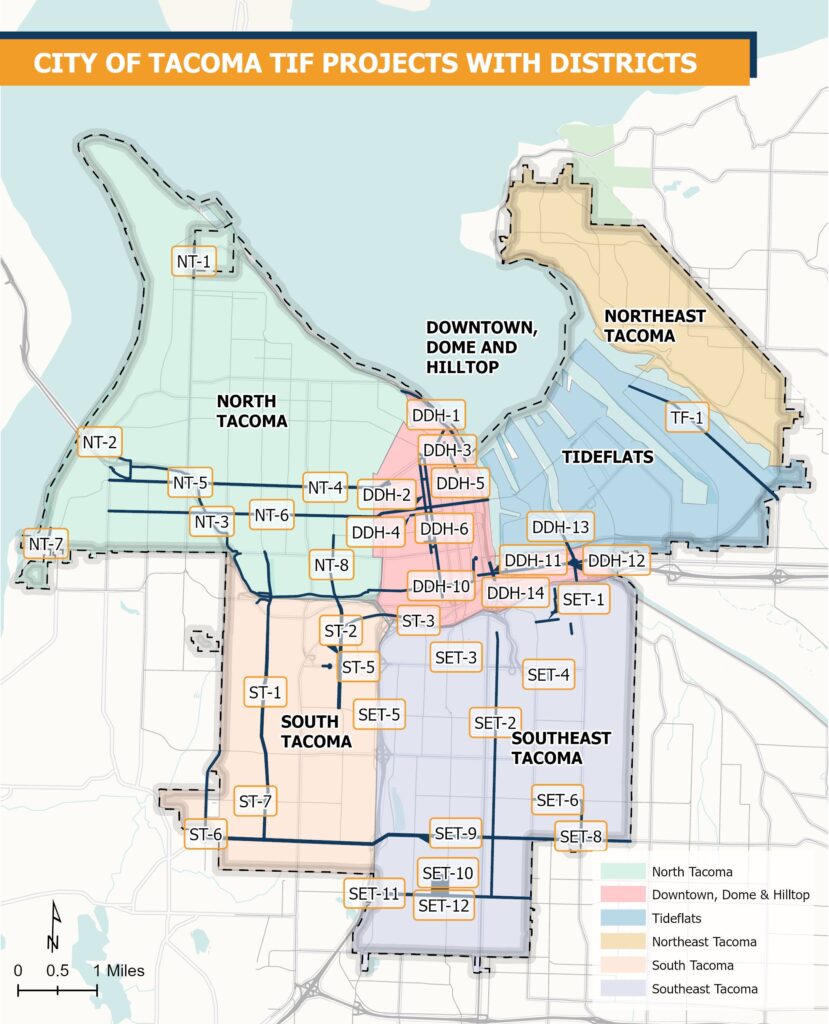
Transportation Impact Fees
Transportation Impact Fees are one-time charges assessed to new developments to pay a portion of the costs of new infrastructure capacity necessary to accommodate new growth. Multiple statutes provide cities the authority to impose impact fees to fund improvements. Most commonly, cities apply impact fees using the authority provided by the Growth Management Act.
Background
The City of Tacoma has experienced significant growth over the past decade. While this expansion has offered new residential opportunities, local jobs, and services, it has also strained the public infrastructure, including roads, parks, schools, and emergency services that our community relies on. The City is committed to providing public infrastructure that meets the needs of our community and impact fees are a potential source for funding this infrastructure.
Like many local agencies, the City of Tacoma has a significant gap in infrastructure funding. While the City Council and voters have taken meaningful and responsible measures to address some of this need—particularly when it comes to maintaining existing transportation infrastructure—the investments required to accommodate future growth are still underfunded.
The City of Tacoma is proposing Transportation Impact Fees to help fund resources that all Tacomans use—things like roads, sidewalks, bike lanes, and trails. Transportation Impact Fees are one-time charges to new developments to help fund a portion of the costs of new infrastructure needed to support new growth.
Watch the short video below to learn more about Transportation Impact Fees and how they could benefit our community.
Transportation Impact Fees Explained
-
Transportation Impact Fees are based on how many trips the new development would create. For example, a single-family home would have much less impact than a large grocery store, so the fee would be substantially less for a home. The greater the impact a new development would have on our transportation system, the higher its rate would be.
Impact fees would apply to all types of development that affect the transportation system in different ways—like housing, retail establishments, movie theaters, hospitals, offices, and manufacturing. The impact fee rate would be higher for land use categories that generate more trips and lower for categories that generate fewer trips.
Impact fees would be one of many tools that helps pay to build Tacoma’s transportation system—along with federal and state grants, gas tax revenues, local taxes you pay, and other sources.
-
Tacoma’s impact fee program will be developed to reflect Tacoma’s values: integrity, service, excellence, and equity. This means consistency with major city initiatives like Home in Tacoma, which paves the way for more diverse, affordable, and sustainable housing options in Tacoma.
The City’s impact fee program could provide robust exemptions and reductions for low-income housing and middle-housing, ensuring that this program continues to encourage affordable housing, while also helping build and sustain the transportation options that people traveling to and from these new developments will need.
-
Transportation Impact Fees would pay for specific projects that are on the impact fee project list. This list would be updated every few years with input from the public.
Each project on the list is expected to be built using a combination of impact fee funds plus funding from grants or other sources. Examples of projects that could be funded by impact fees include: Complete Streets improvements on 6th Avenue in North Tacoma; development of a protected bikeway on Tyler Street in South Tacoma; and intersection updates, like the 21st and C Street intersection in Downtown Tacoma.
-
Impact fee revenues cannot be used to fund things like pothole repair, transit service hours and transit vehicles, and operations and maintenance costs.
However, funds can be used for things that add new capacity such as:
- Streets and roadway realignments.
- New bikeways and bicycle facilities.
- Sidewalks.
- Pedestrian crossings.
- Turn lanes.
- Signal upgrades and roundabouts that make our intersections more efficient.
-
The City of Tacoma is looking to craft its Transportation Impact Fee program to help fund high-priority transportation projects across the city. The projects proposed for inclusion in the program vary in terms of complexity and cost, and most are active transportation projects, improving capacity for people walking, rolling, and bicycling.
See the full list of eligible projects.


We’re committed to keeping the community informed as Tacoma’s Transportation Impact Fees proposal moves forward. Following recent outreach meetings, we’ll return to the Tacoma City Council Study Session on October 28, 2025 and Tacoma City Council Regular Meeting on December 2, 2025 to present updates and next steps.